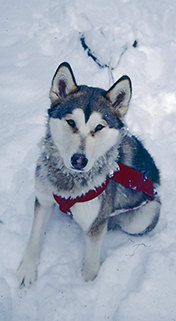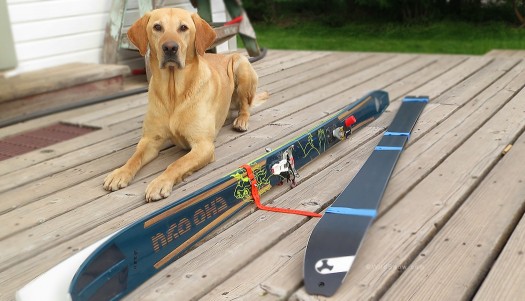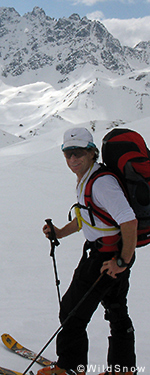
Princess, 1982-1987
I had a dog once. In fact, I’ve had several canines. Mister Brown was a family Weimaraner — an undisciplined maniac totally suited to my eccentric family during my pre-teen years. He died of dystemper, on my bed. Princess was my adult dog, if you could call me “adult” back then. She ran free as well, actually too free. One day in Crested Butte she ranged away and got hit by a truck while rousting birds next to the highway. Husky shepherd mixes tend to get involved in stuff like that. Princess is buried up off the East River road, thanks R for helping me dig the hole.
Both dogs died young. Really young even for dogs. But most of our beloved dogs pass on after just a few years due to genetics, poor training and resulting accidents, or a variety of other causes. They all die young. Sadness any dog owner knows all too well. Can we fix this, or at least mitigate? Perhaps.
That’s the promise of best selling dog book writer Ted Kerasote’s new read, “Pukka’s Promise — The Quest for Longer-Lived Dogs.”
Where do you even begin with a book this encyclopedic? Beyond starting, will you ever finish? First, take my word for it, if you’re a dog lover or have ever loved a pooch, this book is mandatory reading. Even me, the dog cynic, couldn’t put it down. Through 452 pages, Kerasote weaves the story of selecting and rearing what has to be the healthiest, happiest and best trained “mountain” dog on the planet, while all the while presenting what amounts to an encyclopedia of new-school dog health knowledge.

'Aha.' 'I smell skis. What is next, a bit of mountain fun kind sir?' The celebrity Pukka at WildSnow HQ .
I found every chapter fascinating. For example, Kerasote rightly equates how a dog eats with much of how healthy a dog is. To that end he does an amazing journey through the world of dog food. To the extent he ends up researching the subject of rendering.
For those that don’t know, rendering is probably one of the least known industries in the civilized world. Why? Because it’s disgusting and all about death. But as Kerasote states, modern society could not exist without rendering as it reduces all meat bi-products to usable materials instead of just dumping millions of things like animal carcasses into land fills, or attempting to incinerate and thus using vast amounts of energy while contributing to air pollution.
Rendering relates to dog health as some of the resulting proteins and fats are used in dog food. But it also has an ethical component, as one has to wonder as Kerasote does “is fido eating rover?”
While rumors and urban legends have an amusing variety of takes about rendering (it sounds like a dream for mafia hit men), it turns out that DNA testing can ID which species are in pet foods. Results show that no dog, cat or horse DNA were present in sampling of pet foods during attention to this issue in 1998. That’s not saying that it couldn’t happen, as a rendered cat is ultimately no different than a rendered cow. But those results are encouraging, and more, we have Kerasote to get to the bottom of the issue.
To that end, Kerasote does a classic bit of investigative reporting. He contacts rendering companies, goes to the plants when he can, and personally witnesses everything from a dystopian rendering plant where indeed it appeared various species could be inadvertently mixed, to the “Taj” of rendering, where it’s obvious everything is done on the up-and-up.
Ultimately, one gleans from reading “Pukka’s Promise” that while we must first depend on the rendering process to get the right things into kibble, the food industry itself ostensibly is very strict about no pet by-products going into pet food. Is that 100% confidence? I’d say not, and while Kerasote doesn’t state a conclusion, he implies his take in an obvious way: he feeds Pukka an amazing diet of frozen and fresh meat, augmented by some high-end kibble that’s commonly acknowledged to have excellent ingredients.
Don’t get me wrong. The sections in Kerasote’s book about rendering are almost a side note. Other subjects include spaying/neutering verses leaving dogs intact (or at least sterilized in such a way as to not mess their hormones — highly controversial), how vaccinations should be used wisely, issues with the animal shelter systems of the world, and so much more. All related to dog health in a fascinating and enlightening way.
Threading it all together is Kerasote’s story of raising Pukka to be the ultimate mountain athlete companion dog. Pukka hunts elk with his “person.” He’s the prince of his village. He “skis” down the Tetons. He can ace out any other dog when that ball is tossed and chased down. He’s a bird dog. He learned not to bark. Pukka graduates to an adult with backpacking in the Wind Rivers and a swim in an alpine lake below, you guessed it, Dog Tooth Peak.
As for me, I’m feeling a bit inadequate when it comes to Princess and Mister Brown. If Princess had been a mountain dog like Pukka, she’d have learned how to behave around roads and automobiles — and probably not roamed as far a she did. Karasote is one to know, as back in our day Ted skied with Princess here in the Elk Mountains of Colorado. I’m embarrassed to think he saw what a poor job I’d done, so I’ll own up to it. At least I have the excuse of being young and stupid. Mister Brown, he probably needed better vaccinations and would have lived more years. Will I ever have another dog? I’ll admit, Kerasote makes me think about it.
Ted Kerasote
4 Questions – Ted Kerasote
Ted, what’s your favorite thing to do with Pukka?
Probably backcountry skiing. Pukka loves skiing as I do. Dogs love light density snow because just like us they can enjoy the feeling of flying as they leap downhill. You can see how much they enjoy it; it’s so obvious. Pukka does his share and breaks trail, and he understands hand signals.
How about Pukka’s favorite?
Undeniably skiing. After that, he likes to prune sticks off spruce trees and retrieve them. He does that with a human, or plays what I call “fetch solitaire” by placing the stick on the powder snow, sticking his snout underneath it, flipping the stick up, and catching it. Dogs also enjoy being outdoors in winter because of the fur coats they wear. In the summer they can suffer from the heat. Winter gives them an opportunity to be comfortable.
One tip for raising a puppy to be a mountain dog?
Don’t overdo it. Puppies are like young kids, their bones are still forming. Too much hard going when they’re young can set them up for orthopedic problems as they age and can drastically shorten the time they have to enjoy the mountains with you. Remember that due to their enthusiasm a puppy won’t self-regulate their level of activity when accompanying you in the mountains.
Top 3 things to help our dogs live longer? (Note: Teds’s book clarifies the brief points below).
1.) Feed them low-grain or no-grain diet that includes green leafy and yellow-orange vegetables.
2.) Minimally vaccinate.
3.) Keep them away from environmental pollutants.
WildSnow.com publisher emeritus and founder Lou (Louis Dawson) has a 50+ years career in climbing, backcountry skiing and ski mountaineering. He was the first person in history to ski down all 54 Colorado 14,000-foot peaks, has authored numerous books about about backcountry skiing, and has skied from the summit of Denali in Alaska, North America’s highest mountain.

